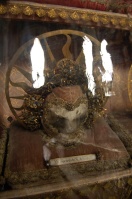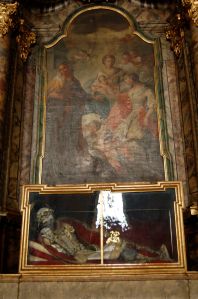Tags
Austria, chapel, Hall in Tirol, martyr, relic, reliquary, Roman Martyrology, Saint Agapitus, Saint Constantius, skeleton, skull
The Pfarrkirche (Parish Church) St. Nikolaus in Hall in Tirol, Austria — approximately 10 km from Innsbruck — houses an impressive display of holy relics. The Waldauf Chapel, located in the northern part of the nave, is named for Florian Waldauf zu Waldenstein, an Austrian knight who bequeathed his collection of relics to the church upon his death in 1501.
 Pfarrkirche St. Nikolaus was established in 1281 and was initially Gothic in style. Over the centuries, however, enlargement of the church and the addition of increasingly elaborate ornamentation changed the character of the interior, infusing it with a distinctly Baroque appearance. The high altar, pictured in the distance above, is the work of Erasmus Quellinus II, a student of Peter Paul Rubens. Interior frescoes were added in 1752 by Adam Mölk, a court painter to Empress Maria Theresa.
Pfarrkirche St. Nikolaus was established in 1281 and was initially Gothic in style. Over the centuries, however, enlargement of the church and the addition of increasingly elaborate ornamentation changed the character of the interior, infusing it with a distinctly Baroque appearance. The high altar, pictured in the distance above, is the work of Erasmus Quellinus II, a student of Peter Paul Rubens. Interior frescoes were added in 1752 by Adam Mölk, a court painter to Empress Maria Theresa.
Florian Waldauf’s collection of relics adorns the northern wall of the eponymous chapel. Dozens of skulls and an assortment of bones carefully arranged on red velvet cushions  line the interior of a large cabinet, its glass wavy with age. Each skull is veiled with a gauzy fabric, blurring its features, and each is crowned with a golden halo. The effect is grim but striking: glints of gold on ashen bones in the shadows of an ancient church.
line the interior of a large cabinet, its glass wavy with age. Each skull is veiled with a gauzy fabric, blurring its features, and each is crowned with a golden halo. The effect is grim but striking: glints of gold on ashen bones in the shadows of an ancient church.
The collection of relics in the Waldauf Chapel are not the only relics on display in the church, however. Three additional cases along the northern wall, near the center of the nave, appear to contain the remains of additional saints, two of whom are clearly identified. I’m not sure whether these relics are part of Florian Waldauf’s original bequest, but given the prominence of the displays, they are likely the most important of the church’s collection.
A Mysterious Skeleton
 The most conspicuous display contains what appears to be a complete skeleton, recumbent, richly dressed in a red velvet cape, a heavily embroidered jacket, and white silk pants. His right arm is bent at the elbow, and his head is almost poised on his gloved right hand. The glove, probably of white silk, is decorated with jewels. A golden crown formed of loosely gathered leaves adorns his skull, and the hint of a burnished halo is just visible above his head. The case itself is not clearly labeled, so unfortunately I never discovered the identity of the skeleton.
The most conspicuous display contains what appears to be a complete skeleton, recumbent, richly dressed in a red velvet cape, a heavily embroidered jacket, and white silk pants. His right arm is bent at the elbow, and his head is almost poised on his gloved right hand. The glove, probably of white silk, is decorated with jewels. A golden crown formed of loosely gathered leaves adorns his skull, and the hint of a burnished halo is just visible above his head. The case itself is not clearly labeled, so unfortunately I never discovered the identity of the skeleton.
In contrast, the two other repositories flanking the skeleton case are both clearly marked. Each is built into the wall, above eye level, and each contains a single skull atop a pyramid of bones. The first case is labeled in large, gold letters “St. Constantius M.” The second case, similarly marked, reads “St. Agapitus M.” The “M” following the names Agapitus and Constantinus refers to “martyr.”
Saint Agapitus at Pfarrkirche St. Nikolaus
The Roman Martyrology lists seven saints named Agapitus. Saint Agapitus of Palestrina, for example, was fifteen when he was arrested by order of the emperor Aurelian. According to the Roman Martyrology, he was first scourged and then “endured more severe torments, and being delivered to the lions by the emperor’s order without receiving any injury, he was finally struck with the sword . . . .” After his death in 274, a basilica was erected in Palestrina, Italy, at the site of his beheading. His relics are apparently kept there, though several relics were transferred to Besançon, France. Consequently, the bones at Pfarrkirche St. Nikolaus cannot be those of Saint Agapitus of Palestrina.
 Other potential Agapituses include Saint Agapitus the Deacon, who was beheaded in Rome in 258. Saint Agapitus of Synnada, in Phrygia, was a bishop martyred in the 3rd century. Saint Agapitus of Rome was martyred in 188. He was the son of Saints Eustachius and Theophistes and the brother of Saint Theophistus. During the persecutions of Hadrian, all four members of the family were “condemned to be cast to the beasts,” but having escaped unharmed, they were then essentially cooked to death after being “shut up in a burning brazen ox.” Pope Saint Agapitus, “whose sanctity is attested by blessed Gregory the Great,” is also listed in the Roman Martyrology, though it is unclear how he was martyred. He may or may not be the same Pope Saint Agapitus I (or Agapetus I) who served as pope from 13 May 535 until his death on 22 April 536. The latter Pope Saint Agapitus, however, apparently died of illness rather than as a result of martyrdom. He is interred at Saint Peter’s Basilica in Rome. Yet another Saint Agapitus was martyred in Heraclea in Thrace during the early 4th century along with Saints Bassus, Denis, and forty others. Lastly, Saint Agapitus of Ravenna, bishop and confessor, was martyred at Ravenna in the 4th century.
Other potential Agapituses include Saint Agapitus the Deacon, who was beheaded in Rome in 258. Saint Agapitus of Synnada, in Phrygia, was a bishop martyred in the 3rd century. Saint Agapitus of Rome was martyred in 188. He was the son of Saints Eustachius and Theophistes and the brother of Saint Theophistus. During the persecutions of Hadrian, all four members of the family were “condemned to be cast to the beasts,” but having escaped unharmed, they were then essentially cooked to death after being “shut up in a burning brazen ox.” Pope Saint Agapitus, “whose sanctity is attested by blessed Gregory the Great,” is also listed in the Roman Martyrology, though it is unclear how he was martyred. He may or may not be the same Pope Saint Agapitus I (or Agapetus I) who served as pope from 13 May 535 until his death on 22 April 536. The latter Pope Saint Agapitus, however, apparently died of illness rather than as a result of martyrdom. He is interred at Saint Peter’s Basilica in Rome. Yet another Saint Agapitus was martyred in Heraclea in Thrace during the early 4th century along with Saints Bassus, Denis, and forty others. Lastly, Saint Agapitus of Ravenna, bishop and confessor, was martyred at Ravenna in the 4th century.
Saint Constantius at Pfarrkirche St. Nikolaus
The identity of “St. Constantius M.” is equally uncertain. The Roman Martyrology lists several Constantiuses. Saint Constantius of Rome, a priest who opposed the Pelagians, was martyred in Rome c. 418. Saint Constantius of Trier (also known as Trèves) was killed, along with several others, in Trier during the Diocletian persecutions, c. 287. Saint Constantius of Perugia, the first Bishop of Perugia, Italy, was martyred along with members of his congregation during the reign of Marcus Aurelius. He was beheaded in 170. Another Saint Constantius, the son of Saint Simplicius and brother of Saint Victorian, was also martyred during the persecutions of Marcus Aurelius, in Marsica, Italy. This Saint Constantius, along with his father and brother, “were first tortured in different manners, and then being struck with the axe, obtained the crown of martyrdom . . . .” They apparently survived being thrown into a chamber with snakes and scorpions and escaped being torn apart by maddened heifers before they were eventually beheaded at Celano in 159.
In addition to these martyrs, several other Constantiuses have been recognized as saints or beati. For example, Saint Constantius the Bishop was the Bishop of Aquino, Italy. He died c. 520 of natural causes. Saint Constantius of Ancona was, according to the Book of Saints, sacristan of the church of St. Stephen in Ancona, Italy. He died in the latter part of the 6th century and his relics are reportedly kept in Ancona. The Blessed Constantius of Fabriano, also known as Constantius Bernocchi, died of natural causes in 1481.


Pingback: The Catacomb Saints: Bedazzled Skeletons of the Counter-Reformation | Reliquarian